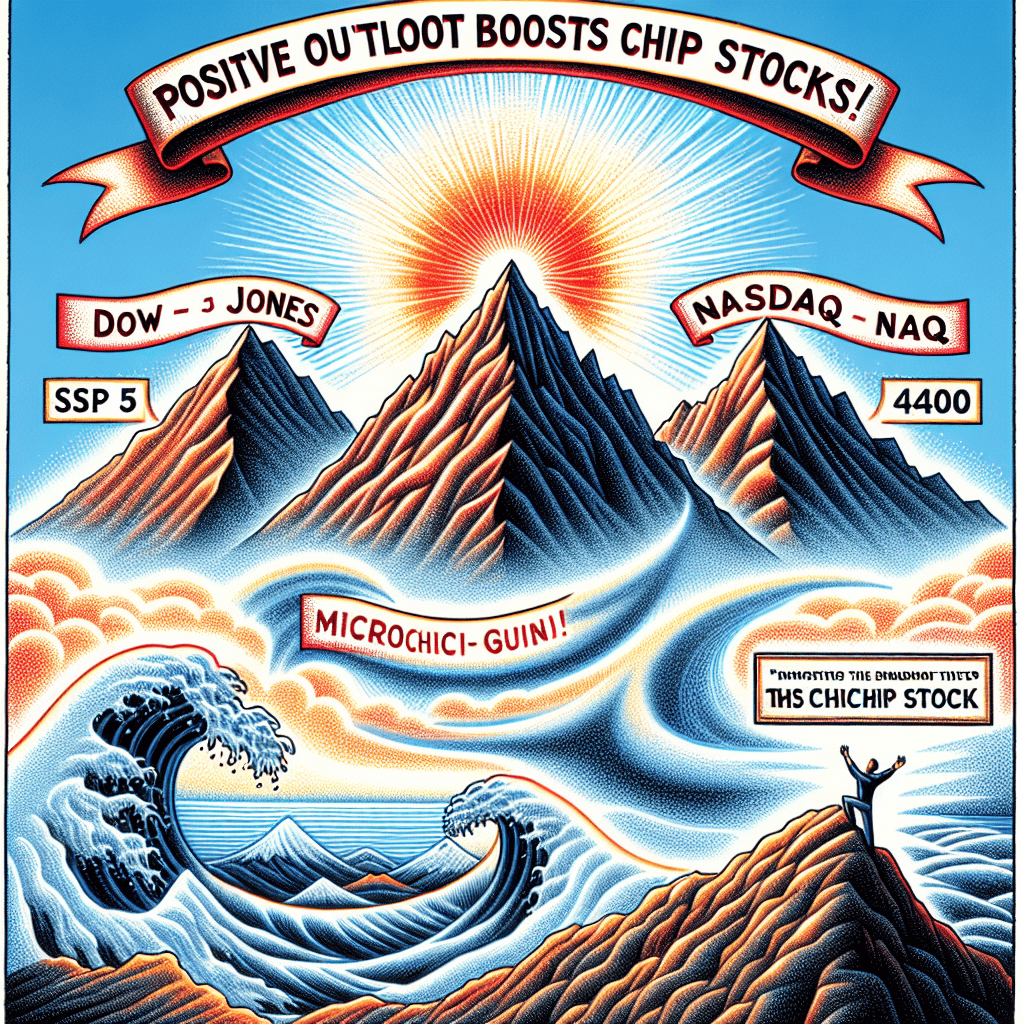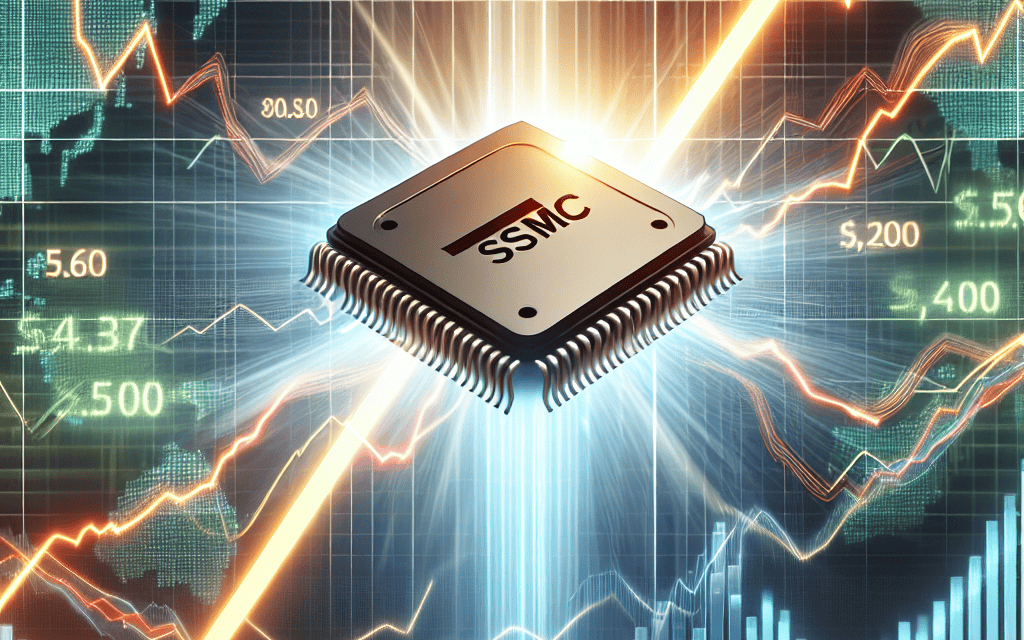“Chip Optimism Fuels Market Rally: Dow, S&P 500, Nasdaq Soar on TSMC’s Bright Forecast”
Introduction
The stock market experienced a notable surge as major indices, including the Dow Jones Industrial Average, S&P 500, and Nasdaq Composite, all posted gains driven by a wave of optimism in the semiconductor sector. This upward momentum was largely attributed to the positive outlook from Taiwan Semiconductor Manufacturing Company (TSMC), a leading player in the global chip industry. TSMC’s encouraging forecast not only bolstered its own stock but also had a ripple effect across the market, lifting the shares of other semiconductor companies and technology stocks. As investors responded to the promising news, the broader market reflected increased confidence in the tech sector’s growth prospects, underscoring the pivotal role of chipmakers in the current economic landscape.
Impact Of TSMC’s Positive Outlook On Global Chip Stocks
The recent surge in the stock market, marked by significant gains in the Dow Jones Industrial Average, the S&P 500, and the Nasdaq Composite, can be largely attributed to the optimistic outlook provided by Taiwan Semiconductor Manufacturing Company (TSMC). As a leading player in the semiconductor industry, TSMC’s positive forecast has had a ripple effect, boosting investor confidence and driving up the value of chip stocks globally. This development underscores the critical role that semiconductor companies play in the broader market, as well as the interconnectedness of global financial systems.
TSMC’s announcement of an improved outlook comes at a time when the semiconductor industry is navigating a complex landscape of supply chain disruptions and fluctuating demand. The company’s ability to project growth and stability has reassured investors, who are keenly aware of the pivotal role semiconductors play in a wide array of industries, from consumer electronics to automotive manufacturing. As a result, TSMC’s positive forecast has not only lifted its own stock but has also buoyed the shares of other major players in the sector, such as Intel, NVIDIA, and AMD. This collective rise in chip stocks has contributed to the overall upward momentum in the stock market.
Moreover, the impact of TSMC’s outlook extends beyond the semiconductor industry, influencing broader market trends. As chip stocks represent a significant portion of major indices like the Nasdaq, their performance can have a substantial effect on the overall market trajectory. The recent gains in these indices reflect the market’s response to TSMC’s forecast, highlighting the importance of semiconductors as a barometer for economic health and technological advancement. This positive sentiment has been further amplified by the growing demand for advanced technologies, such as artificial intelligence and 5G, which rely heavily on semiconductor innovation.
In addition to boosting investor confidence, TSMC’s outlook has also prompted a reevaluation of the global supply chain dynamics. The semiconductor shortage that has plagued various industries over the past few years has underscored the need for increased production capacity and diversification of supply sources. TSMC’s commitment to expanding its manufacturing capabilities and investing in cutting-edge technologies is seen as a strategic move to address these challenges. Consequently, this has sparked discussions among policymakers and industry leaders about the importance of fostering a resilient and sustainable semiconductor ecosystem.
Furthermore, the positive market reaction to TSMC’s outlook highlights the growing recognition of the semiconductor industry’s strategic importance. As countries around the world strive to enhance their technological capabilities and secure their supply chains, semiconductors have emerged as a focal point of economic and geopolitical considerations. This has led to increased government support and investment in semiconductor research and development, further fueling the industry’s growth prospects.
In conclusion, TSMC’s positive outlook has had a profound impact on global chip stocks, driving a surge in major stock indices and reinforcing the critical role of semiconductors in the modern economy. The ripple effects of this development extend beyond the financial markets, prompting a reassessment of supply chain strategies and underscoring the strategic importance of the semiconductor industry. As the world continues to embrace technological advancements, the performance and outlook of companies like TSMC will remain a key indicator of market trends and economic health.
Analyzing The Dow’s Surge Amidst Semiconductor Optimism
The recent surge in the stock market, particularly the notable rise in the Dow Jones Industrial Average, the S&P 500, and the Nasdaq Composite, can be largely attributed to the optimistic outlook provided by Taiwan Semiconductor Manufacturing Company (TSMC). This positive sentiment has significantly boosted chip stocks, which play a crucial role in the broader market dynamics. As investors digest this development, it is essential to analyze the factors contributing to this upward trend and understand its implications for the market.
To begin with, TSMC’s announcement of a favorable outlook has instilled confidence among investors, leading to a ripple effect across the semiconductor industry. As the world’s largest contract chipmaker, TSMC’s performance and projections are often seen as a bellwether for the entire sector. The company’s positive guidance suggests robust demand for semiconductors, which are integral to a wide range of industries, from consumer electronics to automotive manufacturing. This demand is further fueled by the ongoing digital transformation and the proliferation of technologies such as 5G, artificial intelligence, and the Internet of Things.
Moreover, the semiconductor industry has been grappling with supply chain disruptions and shortages over the past few years. TSMC’s optimistic outlook indicates potential improvements in these areas, which could alleviate some of the bottlenecks that have hindered production and distribution. As a result, investors are increasingly optimistic about the sector’s ability to meet growing demand, thereby driving up stock prices.
In addition to TSMC’s influence, the broader economic environment has also played a role in the stock market’s recent performance. The Federal Reserve’s monetary policy, characterized by low interest rates and quantitative easing measures, has provided a supportive backdrop for equities. This accommodative stance has encouraged investors to seek higher returns in the stock market, further propelling indices like the Dow, S&P 500, and Nasdaq.
Furthermore, the global economic recovery from the COVID-19 pandemic has contributed to the positive sentiment in the markets. As vaccination rates increase and restrictions ease, economic activity is picking up, leading to improved corporate earnings and growth prospects. This recovery is particularly beneficial for cyclical sectors, including technology and semiconductors, which tend to perform well during periods of economic expansion.
However, it is important to consider potential risks that could temper this optimism. Geopolitical tensions, particularly those involving major semiconductor-producing regions, could disrupt supply chains and impact the industry’s growth trajectory. Additionally, inflationary pressures and potential changes in monetary policy could pose challenges for the stock market in the future.
In conclusion, the recent surge in the Dow, S&P 500, and Nasdaq can be largely attributed to TSMC’s positive outlook, which has bolstered confidence in the semiconductor sector. This development, coupled with supportive economic conditions and a recovering global economy, has created a favorable environment for equities. Nevertheless, investors should remain vigilant and consider potential risks that could affect market dynamics. As the situation evolves, continued analysis and monitoring of these factors will be crucial for making informed investment decisions.
S&P 500’s Growth Driven By Tech Sector Resurgence
The recent surge in the stock market, particularly the notable rise in the Dow Jones Industrial Average, S&P 500, and Nasdaq Composite, can be largely attributed to the optimistic outlook provided by Taiwan Semiconductor Manufacturing Company (TSMC). This positive sentiment has significantly boosted chip stocks, which play a crucial role in the broader technology sector. As investors digest TSMC’s encouraging forecast, the ripple effects are being felt across the market, with the S&P 500 experiencing substantial growth driven by a resurgence in the tech sector.
TSMC, a leading player in the semiconductor industry, recently reported a robust outlook for the coming quarters, citing strong demand for its advanced chips. This announcement has instilled confidence among investors, who view the semiconductor industry as a bellwether for technological innovation and economic growth. The company’s positive projections have not only lifted its own stock but have also had a cascading effect on other major chipmakers and tech companies. As a result, the tech-heavy Nasdaq Composite has seen a significant uptick, reflecting the renewed investor interest in technology stocks.
The S&P 500, which includes a substantial representation of technology companies, has been a direct beneficiary of this tech sector resurgence. The index’s growth is being propelled by the strong performance of major tech firms, which are capitalizing on the increased demand for semiconductors. This demand is driven by a variety of factors, including the ongoing digital transformation across industries, the proliferation of artificial intelligence applications, and the expansion of 5G networks. These trends underscore the critical role that semiconductors play in enabling technological advancements and driving economic progress.
Moreover, the tech sector’s resurgence is not only a result of TSMC’s positive outlook but also reflects broader market dynamics. Investors are increasingly optimistic about the potential for continued innovation and growth within the technology industry. This optimism is further fueled by the expectation that tech companies will continue to deliver strong earnings, supported by their ability to adapt to changing market conditions and leverage emerging technologies. Consequently, the S&P 500’s growth is being bolstered by the robust performance of its tech constituents, which are well-positioned to capitalize on these favorable trends.
In addition to the direct impact of TSMC’s outlook, the broader economic environment is also contributing to the stock market’s upward trajectory. With central banks maintaining accommodative monetary policies and governments implementing fiscal stimulus measures, the economic backdrop remains supportive of equity markets. This environment has created a favorable setting for risk assets, encouraging investors to allocate capital to stocks, particularly those in high-growth sectors like technology.
As the stock market continues to rally, driven by the tech sector’s resurgence, it is important for investors to remain vigilant and consider the potential risks associated with this upward momentum. While the current outlook is positive, factors such as geopolitical tensions, supply chain disruptions, and regulatory changes could pose challenges to the sustained growth of the technology sector. Nevertheless, the recent surge in the S&P 500, fueled by the tech sector’s strength, underscores the critical role that technology plays in shaping the future of the global economy. As such, investors are likely to continue focusing on this dynamic sector as they seek opportunities for growth and value creation in the evolving market landscape.
Nasdaq’s Climb: The Role Of Chipmakers In Market Dynamics

The recent surge in the stock market, particularly the notable rise in the Dow Jones Industrial Average, the S&P 500, and the Nasdaq Composite, can be largely attributed to the optimistic outlook provided by Taiwan Semiconductor Manufacturing Company (TSMC). This positive sentiment has significantly boosted chip stocks, underscoring the pivotal role that chipmakers play in market dynamics. As the global economy becomes increasingly reliant on technology, the semiconductor industry has emerged as a cornerstone of economic growth and innovation. Consequently, any positive developments within this sector tend to have a ripple effect across the broader market.
TSMC, as one of the world’s leading semiconductor manufacturers, holds a substantial influence over the tech industry. Its recent announcement of a favorable outlook has instilled confidence among investors, leading to a surge in stock prices not only for TSMC but also for other companies within the semiconductor supply chain. This optimism is fueled by TSMC’s strategic investments in advanced chip technologies and its ability to meet the growing demand for semiconductors, which are essential components in a wide array of products, from smartphones to automobiles.
The Nasdaq Composite, heavily weighted with technology stocks, has particularly benefited from this positive sentiment. The index’s climb can be attributed to the strong performance of chipmakers, which are integral to the tech sector’s growth. As these companies continue to innovate and expand their capabilities, they drive technological advancements that permeate various industries. This, in turn, enhances productivity and efficiency, further solidifying the importance of chipmakers in the global economic landscape.
Moreover, the semiconductor industry’s influence extends beyond the tech sector. As industries such as automotive, healthcare, and telecommunications increasingly integrate digital technologies into their operations, the demand for semiconductors continues to rise. This cross-industry reliance on chips underscores their critical role in modern economies and highlights why positive news from major players like TSMC can have such a profound impact on market dynamics.
In addition to TSMC’s positive outlook, other factors have contributed to the recent stock market surge. The ongoing recovery from the global pandemic has led to increased consumer spending and business investments, further bolstering economic growth. Additionally, government policies aimed at supporting technological innovation and infrastructure development have provided a conducive environment for the semiconductor industry to thrive. These elements, combined with TSMC’s strategic initiatives, have created a perfect storm for the stock market’s upward trajectory.
As we look to the future, the role of chipmakers in shaping market dynamics is likely to become even more pronounced. With the advent of emerging technologies such as artificial intelligence, 5G, and the Internet of Things, the demand for advanced semiconductors is expected to grow exponentially. This presents both opportunities and challenges for the industry, as companies must navigate supply chain constraints and invest in research and development to stay ahead of the curve.
In conclusion, the recent rise in the Dow, S&P 500, and Nasdaq highlights the significant influence of chipmakers on market dynamics. TSMC’s positive outlook has not only boosted investor confidence but also underscored the critical role that semiconductors play in driving technological innovation and economic growth. As the world becomes increasingly interconnected and reliant on digital technologies, the semiconductor industry will continue to be a key driver of market trends and a barometer of economic health.
TSMC’s Influence On U.S. Stock Indices: A Detailed Overview
The recent surge in the U.S. stock market, marked by significant gains in the Dow Jones Industrial Average, the S&P 500, and the Nasdaq Composite, can be largely attributed to the optimistic outlook provided by Taiwan Semiconductor Manufacturing Company (TSMC). As the world’s largest contract chipmaker, TSMC’s influence on global technology and financial markets is profound, and its positive projections have sent ripples across various sectors, particularly boosting chip stocks.
TSMC’s announcement of an improved forecast for the coming quarters has instilled confidence among investors, who are keenly aware of the company’s pivotal role in the semiconductor industry. This optimism is not unfounded, as TSMC’s advanced manufacturing capabilities and strategic partnerships with leading technology firms position it as a bellwether for the sector. Consequently, the company’s upbeat outlook has led to a rally in semiconductor stocks, which are integral components of major U.S. stock indices.
The Dow Jones Industrial Average, which includes several technology giants that rely on TSMC’s chips, has experienced a notable uptick. This is reflective of the broader market sentiment that anticipates robust demand for semiconductors, driven by advancements in artificial intelligence, 5G technology, and the Internet of Things (IoT). As these technologies continue to evolve, the need for more sophisticated and efficient chips becomes increasingly critical, thereby enhancing TSMC’s market position and, by extension, the performance of related stocks.
Similarly, the S&P 500, a more comprehensive index that encompasses a wide array of industries, has also benefited from TSMC’s positive outlook. The semiconductor sector’s health is often seen as a barometer for the technology industry at large, and its strength can have far-reaching implications for other sectors reliant on technological innovation. As companies across various industries integrate more advanced technologies into their operations, the demand for high-performance chips is expected to rise, further bolstering the S&P 500.
The Nasdaq Composite, heavily weighted towards technology and semiconductor stocks, has perhaps seen the most pronounced impact from TSMC’s forecast. Given its composition, the Nasdaq is particularly sensitive to developments within the tech sector, and TSMC’s positive outlook has provided a much-needed boost. Investors are increasingly optimistic about the growth prospects of tech companies that depend on TSMC’s cutting-edge semiconductor solutions, leading to a surge in stock prices within the index.
Moreover, TSMC’s influence extends beyond immediate market reactions. Its strategic decisions, such as expanding production capacity and investing in new technologies, have long-term implications for the semiconductor industry and, by extension, the global economy. As TSMC continues to innovate and meet the growing demands of its clients, its impact on U.S. stock indices is likely to persist, reinforcing the interconnectedness of global markets.
In conclusion, TSMC’s positive outlook has played a crucial role in the recent surge of U.S. stock indices, underscoring the company’s significant influence on the semiconductor industry and the broader market. As technological advancements continue to drive demand for semiconductors, TSMC’s strategic position and forward-looking approach are poised to sustain its impact on the Dow, S&P 500, and Nasdaq, highlighting the intricate linkages between global technology leaders and financial markets.
The Future Of Semiconductor Stocks In A Bullish Market
The semiconductor industry has long been a cornerstone of technological advancement, driving innovation across various sectors from consumer electronics to automotive and industrial applications. Recently, the stock market has witnessed a significant surge, with major indices such as the Dow Jones Industrial Average, the S&P 500, and the Nasdaq Composite experiencing notable gains. This upward momentum can be largely attributed to the positive outlook provided by Taiwan Semiconductor Manufacturing Company (TSMC), a leading player in the semiconductor space. TSMC’s optimistic forecast has not only bolstered its own stock but has also had a ripple effect, boosting the performance of other chip stocks and contributing to the broader market rally.
TSMC’s announcement comes at a time when the semiconductor industry is navigating a complex landscape characterized by both challenges and opportunities. On one hand, the sector faces supply chain disruptions and geopolitical tensions, which have raised concerns about the stability of chip supply. On the other hand, the increasing demand for semiconductors, driven by emerging technologies such as 5G, artificial intelligence, and electric vehicles, presents a promising growth trajectory. TSMC’s positive outlook suggests that the company is well-positioned to capitalize on these opportunities, thereby instilling confidence among investors and stakeholders.
The impact of TSMC’s forecast extends beyond its own operations, as it sets a precedent for other companies within the semiconductor industry. Investors are now closely monitoring the performance of other key players, such as Intel, NVIDIA, and AMD, to gauge the overall health and potential of the sector. The positive sentiment surrounding TSMC has led to increased investor interest in these companies, further driving up their stock prices and contributing to the bullish market environment.
Moreover, the semiconductor industry’s growth prospects are closely tied to the broader technological landscape. As digital transformation accelerates across various industries, the demand for advanced chips is expected to rise exponentially. This trend is likely to sustain the momentum in semiconductor stocks, as companies continue to innovate and expand their product offerings to meet the evolving needs of their customers. Consequently, the current market surge may be indicative of a longer-term bullish trend for semiconductor stocks, provided that companies can effectively navigate the challenges and capitalize on the opportunities that lie ahead.
In addition to the technological drivers, macroeconomic factors also play a crucial role in shaping the future of semiconductor stocks. The global economic recovery, coupled with supportive monetary policies, has created a favorable environment for equity markets. As economies rebound from the impacts of the COVID-19 pandemic, consumer spending and business investments are expected to increase, further fueling demand for semiconductors. This confluence of factors suggests that the semiconductor industry is poised for sustained growth, with stock market performance reflecting this positive outlook.
In conclusion, the recent surge in the stock market, driven by TSMC’s positive outlook, underscores the critical role of the semiconductor industry in the global economy. As technological advancements continue to reshape industries and drive demand for advanced chips, semiconductor stocks are likely to remain a focal point for investors seeking growth opportunities. While challenges such as supply chain disruptions and geopolitical tensions persist, the industry’s resilience and capacity for innovation position it well for future success. As such, the current bullish market environment may be a harbinger of continued growth and prosperity for semiconductor stocks in the years to come.
Investor Strategies In Light Of TSMC’s Market Impact
The recent surge in the stock market, marked by significant gains in the Dow Jones Industrial Average, the S&P 500, and the Nasdaq Composite, has been largely attributed to the optimistic outlook provided by Taiwan Semiconductor Manufacturing Company (TSMC). As a leading player in the semiconductor industry, TSMC’s positive forecast has not only buoyed its own stock but has also had a ripple effect across the broader market, particularly benefiting chip stocks. This development presents a unique opportunity for investors to reassess their strategies in light of TSMC’s market impact.
To begin with, TSMC’s announcement of robust future demand for its advanced chips has instilled confidence among investors, suggesting a potential upswing in the semiconductor sector. This optimism is grounded in the increasing reliance on semiconductors across various industries, from consumer electronics to automotive and beyond. As a result, investors are now considering the potential for sustained growth in this sector, prompting a reevaluation of their portfolios to capitalize on these emerging opportunities.
Moreover, the positive sentiment surrounding TSMC has extended to other major players in the semiconductor industry, such as Intel, AMD, and Nvidia. These companies have seen their stock prices rise in tandem with TSMC’s, reflecting a broader market confidence in the sector’s growth prospects. For investors, this presents a strategic opportunity to diversify their holdings within the semiconductor space, potentially enhancing their returns by tapping into the sector’s anticipated expansion.
In addition to the direct impact on semiconductor stocks, TSMC’s outlook has also influenced related industries, such as technology and manufacturing. As semiconductors are integral components in a wide array of products, the anticipated growth in chip production is likely to drive demand in these sectors as well. Consequently, investors may consider broadening their investment strategies to include companies that stand to benefit from increased semiconductor availability, such as those involved in the production of consumer electronics, electric vehicles, and industrial automation.
Furthermore, the current market conditions underscore the importance of staying informed about global supply chain dynamics. The semiconductor industry has faced significant challenges in recent years, including supply chain disruptions and geopolitical tensions. However, TSMC’s positive outlook suggests a potential easing of these issues, which could further bolster investor confidence. By closely monitoring developments in this area, investors can make more informed decisions and adjust their strategies accordingly to mitigate risks and seize opportunities.
In light of TSMC’s market impact, it is also crucial for investors to consider the broader economic context. While the semiconductor sector appears poised for growth, external factors such as interest rate fluctuations, inflationary pressures, and geopolitical uncertainties could influence market dynamics. Therefore, maintaining a balanced and diversified portfolio remains a prudent approach, allowing investors to navigate potential volatility while capitalizing on growth opportunities.
In conclusion, TSMC’s positive outlook has provided a significant boost to the stock market, particularly benefiting chip stocks and related industries. For investors, this development presents an opportunity to reassess their strategies, focusing on diversification within the semiconductor sector and related industries. By staying informed about global supply chain dynamics and considering the broader economic context, investors can position themselves to capitalize on the anticipated growth in the semiconductor industry while managing potential risks. As always, a balanced and informed approach remains key to successful investing in an ever-evolving market landscape.
Q&A
1. **What caused the stock market surge?**
The stock market surge was caused by TSMC’s positive outlook, which boosted chip stocks.
2. **Which major stock indices experienced a rise?**
The Dow Jones Industrial Average, S&P 500, and Nasdaq Composite all experienced a rise.
3. **What is TSMC?**
TSMC stands for Taiwan Semiconductor Manufacturing Company, a leading semiconductor manufacturer.
4. **How did TSMC’s outlook affect the market?**
TSMC’s positive outlook led to increased investor confidence in the semiconductor sector, driving up stock prices.
5. **Which sector benefited the most from TSMC’s outlook?**
The semiconductor sector benefited the most from TSMC’s positive outlook.
6. **What is the significance of the semiconductor industry in the stock market?**
The semiconductor industry is crucial as it supports a wide range of technology products, influencing tech stock performance and broader market trends.
7. **Did any specific chip stocks see significant gains?**
While the question does not specify, typically, major chip stocks like NVIDIA, AMD, and Intel might see gains following positive news from TSMC.
Conclusion
The recent surge in the stock market, marked by significant gains in the Dow, S&P 500, and Nasdaq, can be attributed to the positive outlook from Taiwan Semiconductor Manufacturing Company (TSMC). As a leading player in the semiconductor industry, TSMC’s optimistic forecast has instilled confidence among investors, particularly boosting chip stocks. This development underscores the critical role of semiconductor companies in driving market trends and highlights the broader economic optimism surrounding technological advancements and supply chain improvements. The rally reflects investor sentiment that the semiconductor sector will continue to experience robust growth, potentially leading to sustained market momentum.





